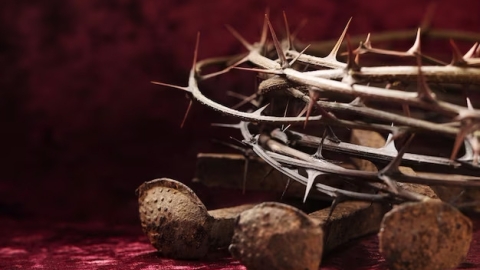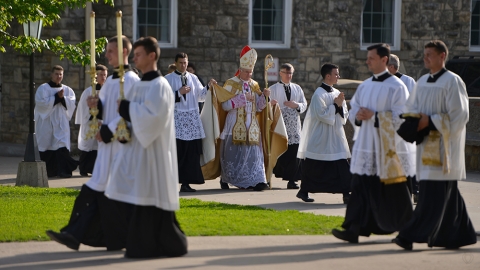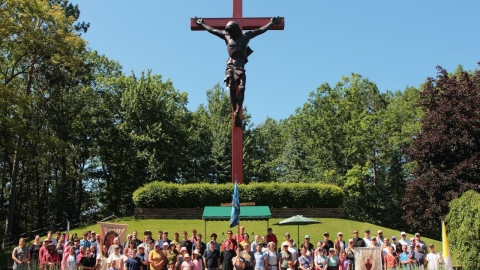Lent Part III: Holy Week

The Stational Church
A full appreciation of the Lenten liturgy presupposes acquaintance with the ancient stational observance. On set days the Christian community of Rome assembled in a designated church (ecclesia collecta) and then with the Pope passed in procession to another church, the station church (statio), which was dedicated to some illustrious saint. There the Eucharistic service was celebrated.
So vividly was the station saint before the minds of the assembled people that he seemed present in their very midst, spoke and worshiped with them. Therefore the missal still reads, "Statio ad sanctum Paulum," i.e., the service is not merely in the church of St. Paul, but rather in his very presence. In the stational liturgy, then, St. Paul was considered as actually present and acting in his capacity as head and pattern for the worshipers. Yes, even more, the assembled congregation entered into a mystical union with the saint by sharing in his glory and by seeing in him beforehand the Lord's advent in the Mass.
What special meaning, however, did the stational liturgy have during Lent? The ancient Roman Church desired to sanctify this important season in the life of the mystical Body by daily Eucharistic worship. She wished to intensify the effect of this service by assembling the whole congregation, by the procession, by the stational church. Baptism, penance, spiritual renewal-these were matters pertaining to the whole community. Catechumens, penitents, and faithful should therefore pass together through the streets in song and prayer. The zeal of one should encourage the other, the fresh enthusiasm of the catechumen should edify all. Then also the place, the church of the stational saint, would have a special elevating effect. His example, his words, his very person, stood vividly before the congregation. Such was the method of conversion employed by the ancient Church. The opus operatum and the opus operantis worked together, the sacramental efficacy of the Eucharist with the powerful psychological impact of the station celebration.
Remember that in the ancient Church holy Mass was not celebrated daily. But in Lent Mass was offered almost every day. The presence of the domnus apostolicus, the Pope, the zeal of the catechumens and penitents, the gathering of many Christians from every quarter, a venerable church as the point of assembly, and the grave of an honored saint as the scene of the liturgy itself, the procession, the homily-none of these valuable psychological factors were overlooked. The station often influenced the choice of pericopes and chants to such an extent that these texts can be understood only in the light of the stational context.
Holy Week
Now we enter the holiest part of Lent. The Church has prepared us step by step for this sacred experience. A steady crescendo in the liturgy has been taking place since Septuagesima Sunday. Each week the sound rose higher, and louder. Although Mother Church often spoke about the Cross and the resurrection, she did so in veiled signs and figures, as if she feared exposing a most precious object to profane eyes. Not until this moment does she remove the curtain. Now we see the Holy of Holies; and more than that, we are asked to participate in the most sublime drama of religious history.
The greatest and holiest of weeks is about to begin. We should not call it a week of mourning, for Cross and resurrection are inseparable. Christ's redemptive work did not end with death, it continues on in the victory of His resurrection. Therefore, we must not separate the passion from the resurrection, but rather regard the Cross as the way to Easter victory.
The liturgy does not make this week one of sorrowful lamentation or tearful sympathizing with our suffering Lord. That was the medieval approach. No, through the whole week there runs a note of victory and joy, a realization that Christ's sacred passion was a prerequisite to Easter glory. We cannot understand the Church's liturgy unless we keep this in mind.
There is no day in the entire coming week when the theme of Easter and victory does not resound loud and clear. Think only of Palm Sunday with its homage to the King; of Holy Thursday with its solemn Mass and consecration of the Holy Oils; of Good Friday with the solemn exaltation of the Cross; of Holy Saturday, the beginning of the Easter solemnities.
Four days take on special importance, viz., Palm Sunday and the sacred Triduum. The remaining three days, Monday through Wednesday, do not differ radically from other days in Passiontide. Palm Sunday may be called the golden gateway leading to the holy mysteries of Easter.
(Taken from Pius Parsch’s The Church’s Year of Grace)
Missed Parts I or II? Click on a link below.





